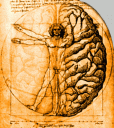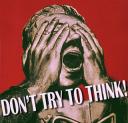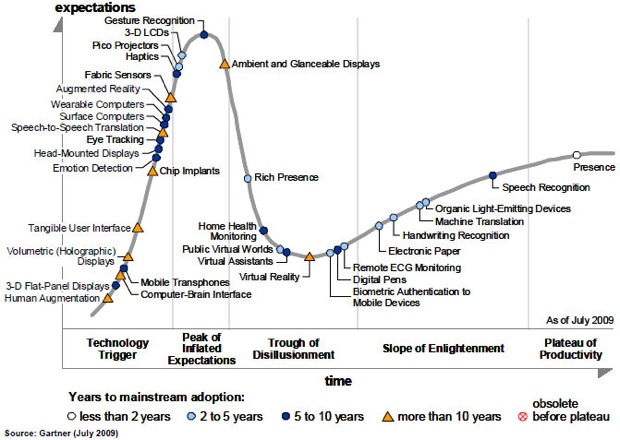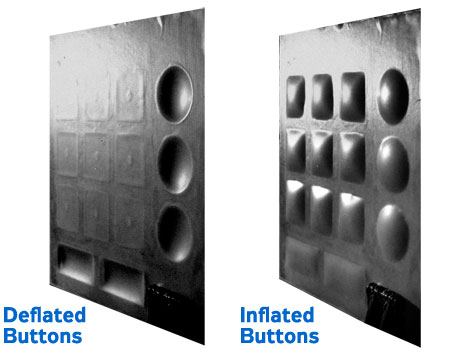Archive for the ‘Related Fields’ Category
Using Lifestyle Medicine to Design For Health
Friday, August 28th, 2009 The most urgent cognitive design problems we face today have to do with creating artifacts that help us make and sustain the lifestyle changes needed to improve health. Much of the cost of healthcare and the morbidity and mortality we experience in advanced countries (especially the US) can be linked to lifestyle choices and otherwise avoidable health risks.
The most urgent cognitive design problems we face today have to do with creating artifacts that help us make and sustain the lifestyle changes needed to improve health. Much of the cost of healthcare and the morbidity and mortality we experience in advanced countries (especially the US) can be linked to lifestyle choices and otherwise avoidable health risks.
Designers that work in this space need to be aware of the enormous range of literature on causes, assessments, interventions and effectiveness that have grown up over the last 20 years or so. A great source is the new initiative on lifestyle medicine launched by the American College of Preventative Medicine. They focus on lifestyle interventions (nutrition, physician activity, smoking cessation, safe sex, stress reduction, etc.) and the effective management of chronic diseases (asthma, diabetes, obesity, cardiovascular disease, cancer, etc.).
Of special interest to cognitive designers is a set of evidence-based guidelines and a supporting literature review for making health-related behavior change.
It is a single source for generating scientifically-grounded design insights and evaluating competing designs across the full range of health-related behavior change challenges.
Grand Challenge Targets Leap in Brain Science
Tuesday, August 4th, 2009Check out the latest from the National Institute of Health on the new Human Connectome Project:
 “The National Institutes of Health Blueprint for Neuroscience Research is launching a $30 million project that will use cutting-edge brain imaging technologies to map the circuitry of the healthy adult human brain. By systematically collecting brain imaging data from hundreds of subjects, the Human Connectome Project (HCP) will yield insight into how brain connections underlie brain function, and will open up new lines of inquiry for human neuroscience.”
“The National Institutes of Health Blueprint for Neuroscience Research is launching a $30 million project that will use cutting-edge brain imaging technologies to map the circuitry of the healthy adult human brain. By systematically collecting brain imaging data from hundreds of subjects, the Human Connectome Project (HCP) will yield insight into how brain connections underlie brain function, and will open up new lines of inquiry for human neuroscience.”
What is exciting, especially from a cognitive design perspective, is:
“In addition to brain imaging, the HCP will involve collection of DNA samples, demographic information and behavioral data from the subjects. Together, these data could hint at how brain connectivity is influenced by genetics and the environment, and in turn, how individual differences in brain connectivity relate to individual differences in behavior. ”
This means it should be a treasure trove of insights for improving how the things we design fit and enhance the human mind.
In Between 3D Buttons and Touch Screens
Wednesday, July 22nd, 2009The folks at Carnegie Mellon University are creating a new interface technology called “inflatable buttons” that combines the cognitive features of physical three dimensional buttons with those of touch or flat screen controls. Sounds like a tweak but it could significantly change the cognitive load and therefore the chance for human error in many applications.
[Bubble Buttons, Source Popular Mechanics]
Check out their two minute YouTube video, Providing Physically Changeable Buttons on a Visual Display.
Chronobiology and Design
Tuesday, June 30th, 2009 In an earlier post, Know Your Employee’s Chronotype, I highlighted an article that argued cognitive performance is influenced by our biological clock or time-of-day-effects. Since then I have been searching for examples of designs that have put that to use. I also received several requests for additional background info that could be used to inform design.
In an earlier post, Know Your Employee’s Chronotype, I highlighted an article that argued cognitive performance is influenced by our biological clock or time-of-day-effects. Since then I have been searching for examples of designs that have put that to use. I also received several requests for additional background info that could be used to inform design.
For those seeking a quick background briefing check out the series of posts on Circadiana called the Clock Tutorials. Short, concise and actionable for designers. I am still looking for great examples of design that leverage our biological clocks.
Step Back to Improve Cognitive Performance
Wednesday, May 6th, 2009 One view on cognition holds that our perceptions, thoughts, feelings and other mental functions are strongly shaped by how our bodies interact with the world. Examples of embodied cognition include talking/thinking with your hands, working things out (solving a problem) by taking a walk, smiling to lift your mood, remembering something by rubbing your head and so on.
One view on cognition holds that our perceptions, thoughts, feelings and other mental functions are strongly shaped by how our bodies interact with the world. Examples of embodied cognition include talking/thinking with your hands, working things out (solving a problem) by taking a walk, smiling to lift your mood, remembering something by rubbing your head and so on.
These effects are not trivial and are likely fundamental to the nature of mind. This means as cognitive designers we must always be on the look out for scientific insights into how we can synchronize mental processes and body movements to improved cognitive performance.
For example, a new study from the Netherlands, Body Locomotion as a Regulatory Process, suggests that physically taking a step back from a difficult situation may in fact trigger higher-order cognitive control functions. The control functions help us direct our behaviors and attentional processes to more effectively deal with the situation. So just as the distraction task of counting to 10 helps us self-regulate our emotions, physically stepping back from a problematical situations will help us self-regulate cognitive resources (e.g. refocus and attend to new information).
First Best Destiny… I Mean Job
Wednesday, April 15th, 2009 Attracting, retaining, developing and getting the most out of today’s knowledge workers is the number one priority for most employers. This is the central challenge for cognitive designers focused on organizational issues.
Attracting, retaining, developing and getting the most out of today’s knowledge workers is the number one priority for most employers. This is the central challenge for cognitive designers focused on organizational issues.
The idea is simple. If I can understand how minds (individual, group and even machine) really work then I should be able to design a workplace to maximize a return on/for talent.
So I am always on the look out for new scientific insights into the cognition of workplace and service productivity. One such insight can be found in the article Three Lessons for Creating Flourishing, that summarizes several keynotes from the 2nd Applied Positive Psychology Conference.
 Pay special attention to the second lesson that discusses a case study by Aviva, a large insurance company. They use a strength-based approach rather than a competency-based approach to human resource management and have produce some impressive results.
Pay special attention to the second lesson that discusses a case study by Aviva, a large insurance company. They use a strength-based approach rather than a competency-based approach to human resource management and have produce some impressive results.
The insight is to hire people “made for the job” (uncompromising match to their core strengthens) rather than hiring someone that can do the job and emphasizing skill and competency development.
New Cognitive Science Network Forms
Tuesday, April 14th, 2009The Cognitive Science Network is a great online resource for all manner of scholarly articles on cognition in communication, design, art, culture, math, science and technology. It should be a treasure trove for the cognitive designer.
 Fortunately, abstracts and full articles are free in subject matter e-journals. The network was founded by Mark Turner a professor and chair of cognitive science at Case Western Reserve University. The site is maintained here.
Fortunately, abstracts and full articles are free in subject matter e-journals. The network was founded by Mark Turner a professor and chair of cognitive science at Case Western Reserve University. The site is maintained here.
I am busy chewing through some of the materials and will share any design-related insights I find. I invite readers to do the same.
Design Inspiration from Extreme Mental States
Tuesday, March 31st, 2009 As a cognitive designer I am always on the look out for new scientific insights into extreme mental states such as the aesthetic experience, religious beliefs, sudden enlightenment and the like. My hope is that we can use insights into such states to design more cognitive impact into our otherwise mundane services, programs and products.
As a cognitive designer I am always on the look out for new scientific insights into extreme mental states such as the aesthetic experience, religious beliefs, sudden enlightenment and the like. My hope is that we can use insights into such states to design more cognitive impact into our otherwise mundane services, programs and products.
A recent article, Religious Ideas Burrow into our Brain, tries to unpack the cognitive science of religious belief. The key to their cognitive power lies in the fact that religious beliefs are counter intuitive (concern other worldly entities and events) and yet are strongly endorsed by authority figures such as parents.
The Cognitive Coach
Tuesday, February 17th, 2009I am often asked by coaches and mentors for tips on “how the mind really works” that can help the folks they support. Scientific American Mind has an excellent article filled with good cognitive tips on How to Avoid Choking Under Pressure.
 A key tip: If you have practiced extensively avoid self monitoring during performance. This is great advice because the cognitive processes of conscious monitoring can collide with processes that are automatic. This has nothing to do with performance anxiety or fear, it is more like a “senior moment” created when we ask two very different regions of our brains to work together…. and they don’t.
A key tip: If you have practiced extensively avoid self monitoring during performance. This is great advice because the cognitive processes of conscious monitoring can collide with processes that are automatic. This has nothing to do with performance anxiety or fear, it is more like a “senior moment” created when we ask two very different regions of our brains to work together…. and they don’t.
Coaches sometimes suggest tactics that involve conscious self monitoring. Unfortunately, these can be a prime cause of choking under pressure.
If you are well-practiced just let the learning you have done unfold under the force of unconscious rather than conscious thinking.

